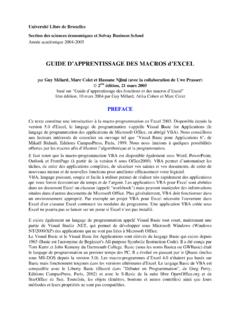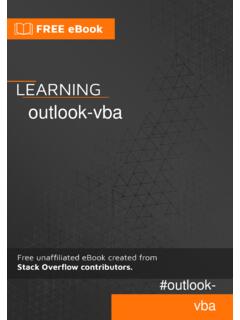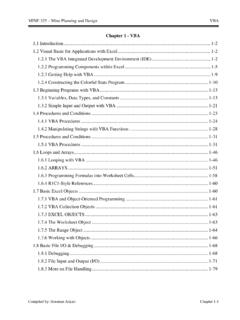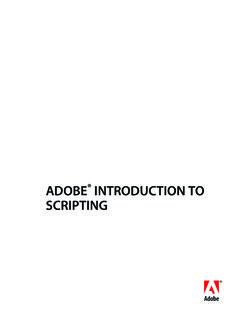Transcription of Excel’s VBA for Complete Beginners
1 MAME and CEUS present, Excel s VBA for Complete Beginners Presented by Charles Cossette Authored by Ken Carney Extended and Modified (a lot) by Charles C. Cossette 1 Table of Contents 1 Introduction What does VBA do? .. 3 2 Getting Started .. 3 Adding the Developer Toolbar .. 3 The visual Basic Editor .. 4 Recording a macro .. 5 EXERCISE 1 - macro Recording .. 6 Excel Dot Notation .. 6 Adding a Button to a Spreadsheet .. 7 EXERCISE 2 Make a button that clears all colors.. 9 Comments .. 10 3 Variables .. 10 Types of Variables .. 10 Variable Practice Properly Referencing the Spreadsheet .. 11 The Worksheets Object .. 11 The Workbooks Object .. 12 Mathematical Operators .. 12 Reading Values from the Spreadsheet .. 13 EXERCISE 3 Code a 13 A Useful Shortcut Declaring Worksheets and Workbooks as Variables .. 13 4 Conditional Logic .. 14 If Statement .. 14 ElseIf and Else Statements .. 14 Conditional Operators .. 15 Logical Operators.
2 15 Some Built-in Functions .. 16 ActiveCell 16 The Cells Object .. 16 The RGB Function .. 16 EXERCISE 4 Automatic Grader (UNFINISHED) .. 17 5 Loops .. 17 For Loops .. 17 EXERCISE 5 Factorial Evaluator .. 18 2 For Each Loops .. 18 EXERCISE 6 Factorial Evaluator Part 2 .. 18 Do While loops .. 19 EXERCISE 7a Toss a coin 1000 times.. 19 EXERCISE 7b Toss 10 coins 1000 times .. 19 6 Strings and String Functions .. 19 LCase and UCase .. 19 Trim, Len, and Space .. 20 Replace .. 20 InStr, InStrRev, StrReverse .. 20 The Left, Right, and Mid Functions .. 20 EXERCISE 8 String Practice .. 21 EXERCISE 9 Email Identifier .. 21 EXERCISE10 E-Week Registration Trend 21 7 Arrays .. 21 Multi-Dimensional Arrays .. 22 The Split Function .. 22 EXERCISE 11 Use a For-Loop to Load an Array .. 22 8 Subs and Functions .. 23 23 Passing Values to Subroutines .. 24 Functions .. 24 Worksheet Functions .. 25 EXERCISE 12 Client Payment Monitor.
3 25 EXERCISE 13 Consolidating Vendor Codes .. 25 9 Events .. 25 EXERCISE 13 A Crosshair .. 26 10 Final Remarks .. 27 3 1 Introduction What does VBA do? VBA stands for visual Basic for Applications. In simple terms, it s a pretty easy programming language that Microsoft added to all their Office products, so that you can write programs that interact its features. This is especially useful in Excel, where you can use VBA to crunch numbers from hundreds of thousands of rows of data, from several different Excel files and beyond. It largely extends Excel s abilities, and certainly becomes a very valuable skill when working with any large company who s got a huge Excel list of anything. Anyways, you ll see. Now, to the point this document is meant for people who have an average knowledge of Excel, but know nothing about VBA. 2 Getting Started Adding the Developer Toolbar Before you can start, you need to add the Developer ribbon to the top of Excel. In Excel 2010 and 2013 click the File menu then select Options.
4 From the dialogue box, click on Customize Ribbon on the left side. From the right hand side you'll then see an area called "Customize the Ribbon". Under "Main Tabs" check the box for Developer: When you have the developer toolbar, you'll see the following tab in the Ribbon (this is from Excel 2013, so you may not have all the items below): 4 In order to run macros without any annoying security warnings, click on macro Security, on the Code panel. Select the option for Enable all macros. Then make sure that "Trust access to the VBA object model" is checked: NOTE: If you're worried about macro security then you can always bring this box up again and disable the macros before you exit Excel. Now that you have the developer tab added to the Ribbon you can do things like bring up the visual Basic Editor, run macros, record macros, and insert form objects onto your spreadsheets. First, let's have a look at the visual Basic Development Environment. This is, after all, where you'll be writing all your code.
5 The visual Basic Editor To open the visual Basic editor, go to the Code panel on the Developer tab and click on the visual Basic button. This should open a window like this. It might seem like a lot at first, but you'll get accustomed to it soon enough. The big grey area is where you'll write your code. The reason it's grey above is because no coding window has been opened yet. To open up a coding screen, click on Insert > 5 Module. The new white area is where you'll write your code. You can try running the classical first program by typing in the following code into this window: Sub HelloWorld() MsgBox ("Hello World!") End Sub To run your program, locate the play button in the toolbar above, , and click "Run Sub/Userform." Congratulations on running the first VBA program. In the case of visual Basic for Applications, these programs that you'll be writing are called Macros. Recording a macro This feature is your new best friend. "Record macro " is a tool that will record whatever actions you use in Excel (selecting cells, typing, creating graphs etc.)
6 It will then create a new module, and have everything you just did translated into VBA code. Let s start with something simple. Go to the developer tab and click on the Record macro button. Name it whatever you want, and make sure the macro will be stored in "This Workbook". 6 Press OK. You're now free to do anything, and it will be recorded in a new module. Let's just grab a random cell, and type something in. We'll type "5" into cell B2. Go back to the "Record macro " button, and click Stop Recording. To view the actions you just did in code, open the VB Editor. You'll see that there is a new module after the one you created before. Double click on this module to see the code: EXERCISE 1 - macro Recording Record a new macro to make some random text a different font, a different font size, and a different colour. When you Complete the exercise above, you should find that Excel adds quite a lot of code for what seems like simple job. However, you should bear in mind that most of what Excel adds is not needed, since it tends to overdo it - your own VBA code will be a lot shorter!
7 Excel Dot Notation Excel VBA uses dot notation to separate the various things you can access and manipulate with the programming language. Dot notation is hierarchical, and usually starts with an object. (In Excel, an object is the thing you're trying to manipulate, such as a worksheet.) After the object, you type a dot. You then specify what you want to do with this object, or what you want to manipulate. The doing is called a method. The manipulating is done via properties or parameters. If all this is confusing, let's try and clear it up. 7 Think of a television. This is an object. We can notate it like this: tv OK, all very simple so far. But you'll need some more information if you were going to buy a television. One thing you may want to know is how big the tv is. To add a size property, you'd do this: You'd want this to equal something, though, so add an equal sign and a size: = "55 inch" We now have an object (the tv) and a property (the size). We also have a value for the size (55 inch).
8 If we wanted to buy this tv then we'd be doing something (buying). We can call this "doing" a method. It is a method of the tv: Example commands in Excel VBA is something like, Range( A3 ).Value = Bacon Which will write Bacon into cell A3. Likewise, the following command (a method) will delete the 3rd row in the currently active Excel sheet: Rows(3).Delete These are just examples, we ll get in to actually introducing these commands soon. Adding a Button to a Spreadsheet A fun feature in Excel is that you can assign macros to buttons on a spreadsheet, and turn the spreadsheet into a sort of user interface. 8 To demonstrate this, we ll start by creating a new macro . Let s record a macro that makes a cell red. Begin recording a macro , name it whatever you want, and Press OK. Pick any cell, make it red, and then go back to the Developer toolbar to stop recording the macro . An alternate way of viewing your code directly is by clicking on the Macros button on the developer toolbar.
9 Press this button to access a list of all your macros, and select the one you just created. You should see a sub like this: 9 Remember that recording macros tends to overdo things. Because you initially picked the cell you wanted to color red, you might see the following line, depending on which cell you chose: Range( B2 ).Select Delete this line. We re doing this because we don t want our macro to always color the same cell when we re-run it again. Now that the macro doesn t pick a cell itself, it will just execute the rest of the code on whatever cell was already selected. To create a button, return to your spreadsheet, and go to the Developer toolbar. Click on the Insert button in the Controls panel, and select the small Button icon. This will allow you to click-and-drag to create a button. Upon placing your button, you will be asked to pick the macro you want to execute when the button is clicked (in versions prior to Excel 2013, you have to right-click the button and choose Assign macro ).
10 Voila! This button will now take any cells you have selected, and make it red. Note that you may also rename the label on the button by right-clicking it and pressing Edit Text. EXERCISE 2 Make a button that clears all colors. Create another button that removes the fills from all the cells on the spreadsheet. Hint: The small grey triangle at the top-left corner of the cells will select all the cells in the spreadsheet. 10 Comments Comments are in green by default, and can be created with an apostrophe. All the code on a line after an apostrophe will be a comment. You ve now become familiar with how to create macros. You see that you do not need the damn semi-colons anymore, and that unlike C, new lines have significance. The following chapters will teach you the rest of the syntax for basic programming. You should know how programming works at this point, since this document will only serve as a brief reminder of programming methods, and syntax. 3 Variables Often, in VBA, we d like to dedicate a place in memory to a variable a dedicated value your code can modify.








